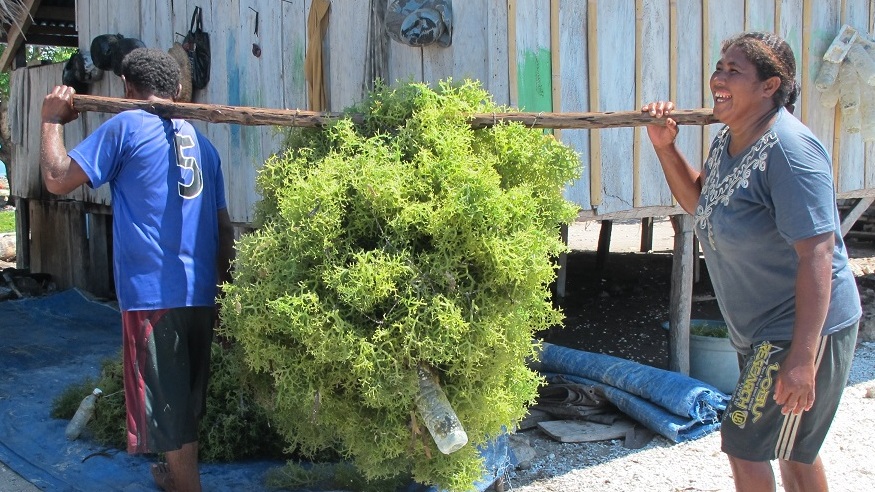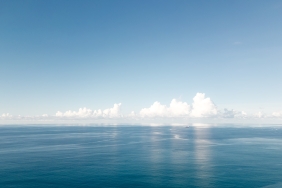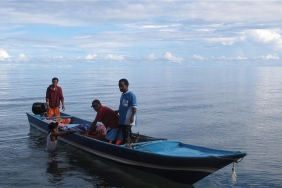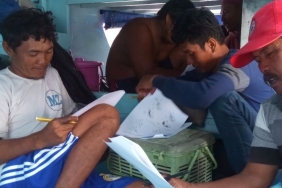SEAWEED NURSERY: A FARMER'S ATTEMPT TO GET BACK ON HIS FEET
Authors: Anastalia Adelady (Fisheries Business Officer, SESS Program) and Idham Malik (Aquaculture Officer), WWF-Indonesia
Communities in Wakatobi have relied on seaweed farming as the main economic support, in addition to fishing and processing coconuts into copra since 1995 by developing cotoni cottoni seaweed. Then in 2010, cultivation activities experienced a decline in production due to pest attacks (ice-ice), so in 2014 farmers began to switch to cultivating the spinosum type. When the price of spinosum fell in the market, farmers switched back to cottoni. Learning from experience, the main problem faced by seaweed farmer groups is the source of seaweed seeds. The seeds used by the farmers are leftover seeds from the harvest, so the growth cycle will not last long, a maximum of two harvest cycles. However, as the duration of seaweed cultivation activities increases and the area of seaweed cultivation increases, the quality of seaweed seeds and the water quality of the cultivation area decreases. These facts were obtained from the results of FGDs with three groups assisted by WWF-Indonesia's Southern-Eastern Sulawesi Seubseascape/SESS Program-Lagundi, Dewara, and Sarope-which were conducted last March.
So far, farmers have been bringing seaweed seeds from outside Wakatobi, which has caused the cultivation production process to be inefficient due to the high cost of seed distribution. Actually, there are also seaweed seeds from local villages or neighboring villages. However, because the seeds are used too often, their quality decreases. This condition can actually be overcome through the mechanism of a self-made seaweed nursery. Therefore, the creation of a seaweed nursery in Wakatobi was initiated with the source of seedlings coming from the results of tissue culture of the Center for Marine Aquaculture/BBPBL Lampung - which was previously produced at the Bogor Biotrop Laboratory.
Pioneer Seedling Farms in Wakatobi: Lagundi, Sarope, and Dewara
There are three assisted groups that are used as pioneers by WWF-Indonesia in establishing nurseries in Wakatobi, namely the Lagundi Group (from Liya Mawi Village), Sarope Group (from South Ollo Village), and Dewara Group (from Derawa Village). On May 16-18, 2106, training on seaweed nursery establishment was conducted with initial materials on seaweed BMPs attended by the three groups. The training was then followed by the practice of seaweed nursery construction for the Lagundi Group - the other two groups followed on June 17-18, 2016. There are several stages in the practice of nursery establishment, namely: surveying potential locations by taking into account current conditions in site selection; making seaweed nursery construction; installing and planting seedlings. the nursery itself is an effort to improve the quality of seaweed and maintain seaweed seed stocks in Wakatobi.
The Lagundi group, which a month earlier had practiced making seaweed seedlings, harvested tissue culture seedlings in the waters of Liya Mawi village on June 16, 2016. The harvest was quite significant, with a growth rate of 1:4 or 50 grams of initial seedlings producing 200 grams of seedlings per seedling point. However, this effort did not necessarily go smoothly, there were obstacles in the form of cat hair pests - fine hairs attached to the stem of seaweed thallus. The farmers then moved the seedlings to a location where cat hair pests were not present and conducted regular seedling cleaning activities in the new nursery location. The following day, June 17-18, 2016, the WWF-Indonesia team along with Mr. Slamet Abadi, a tissue culture seedling developer from BBPBL Lampung, visited the Sarope Group and Dewara Group to assist the groups in installing the nursery construction.
Mr. Juma, one of the seaweed farmers who participated in the training, hoped that this nursery activity could answer the problems faced by farmers in Wakatobi about the difficulty of obtaining seaweed seeds. Not only that, the groups are also expected to become suppliers of seaweed seeds in Wakatobi. After the seaweed nursery activity, the WWF-Indonesia SESS Program field team will monitor the development of seaweed together with the three groups and encourage the strengthening of cooperative relationships between group members to create a nursery institutional system.





